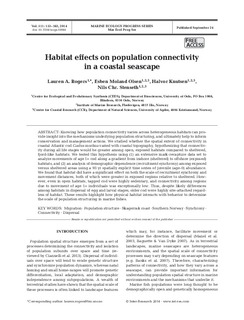| dc.contributor.author | Rogers, Lauren A | |
| dc.contributor.author | Olsen, Esben Moland | |
| dc.contributor.author | Knutsen, Halvor | |
| dc.contributor.author | Stenseth, Nils Chr. | |
| dc.date.accessioned | 2015-03-02T13:48:00Z | |
| dc.date.available | 2015-03-02T13:48:00Z | |
| dc.date.issued | 2014 | |
| dc.identifier.citation | Rogers, L. A., Olsen, E. M., Knutsen, H., & Stenseth, N. C. (2014). Habitat effects on population connectivity in a coastal seascape. Marine Ecology Progress Series, 511, 153-163. doi: 10.3354/meps10944 | nb_NO |
| dc.identifier.uri | http://hdl.handle.net/11250/278159 | |
| dc.description | Published version of an article from: Marine Ecology Progress Series. Also available from Inter Research: http://dx.doi.org/10.3354/meps10944 | nb_NO |
| dc.description.abstract | Knowing how population connectivity varies across heterogeneous habitats can provide insight into the mechanisms underlying population structuring, and ultimately help to inform conservation and management actions. We studied whether the spatial extent of connectivity in coastal Atlantic cod Gadus morhua varied with coastal topography, hypothesizing that connectivity during all life stages would be greater among open, exposed habitats compared to sheltered, fjord-like habitats. We tested this hypothesis using (1) an extensive mark-recapture data set to analyze movements of age 1+ cod along a gradient from inshore (sheltered) to offshore (exposed) habitats, and (2) an analysis of demographic dependence (recruitment synchrony) among exposed versus sheltered areas using a 93 yr spatially explicit time series of juvenile (age-0) abundance. We found that habitat did have a significant effect on both the scale of recruitment synchrony and movement distances, both of which were greater in exposed regions relative to sheltered. However, even in open habitats, tagged cod were highly sedentary, and connectivity among regions due to movement of age 1+ individuals was exceptionally low. Thus, despite likely differences among habitats in dispersal of egg and larval stages, older cod were highly site-attached regardless of habitat. These results highlight how physical habitat interacts with behavior to determine the scale of population structuring in marine fishes. | nb_NO |
| dc.language.iso | eng | nb_NO |
| dc.publisher | Inter Research | nb_NO |
| dc.title | Habitat effects on population connectivity in a coastal seascape | nb_NO |
| dc.type | Journal article | nb_NO |
| dc.type | Peer reviewed | nb_NO |
| dc.subject.nsi | VDP::Agriculture and fishery disciplines: 900::Fisheries science: 920 | nb_NO |
| dc.source.pagenumber | 153-163 | nb_NO |
| dc.source.volume | 511 | nb_NO |
| dc.source.journal | Marine Ecology Progress Series | nb_NO |
